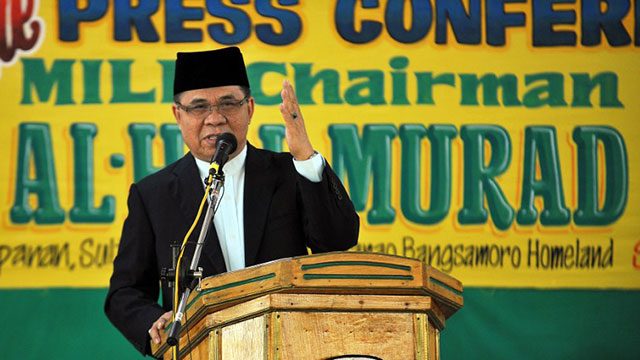SUMMARY
This is AI generated summarization, which may have errors. For context, always refer to the full article.

GENERAL SANTOS CITY, Philippines – He was a feared military commander of the Moro Islamic Liberation Front (MILF) who steered a once ragtag secessionist band of rebels under the shadow of the more ideological and scholarly Hashim Salamat, from whom he inherited the chairmanship of the country’s largest Moro rebel group.
MILF chair Murad “Al Haj” Ebrahim has treaded the thin line between a military man and a statesman as calls and pressures to end decades of violence and turmoil in Mindanao mounted.
On Monday, October 15, Murad will go to Malacañang to sign a preliminary agreement that would hopefully put to rest a region that has seen the worst of wars. He brings with him hopes that the guns and cannons that have snapped the lives of thousands of combatants and civilians will forever be silenced.
It is the violence in his Moro homeland that brought Murad into the movement that for years had pushed for separation from the state. Today he seeks to end that violence, give up his group’s call for independence, and play a key role in ensuring peace.
Rebel leader
Murad was one semester short of finishing his civil engineering course from the Notre Dame of University in Cotabato City when he joined the Moro National Liberation Front in 1972.
For years, he was a largely unknown but leading cadre of the MNLF.
In 1981, Murad joined the Moro Islamic Liberation Front (MILF) following a bitter split and leadership struggle between the late Hashim Salamat and former UP Prof Nur Misuari who was chair of the MNLF. Hashim would form the breakaway MILF; he died of a heart attack in 2003.
Murad rose to become head of the Bangsamoro Islamic Armed Forces (BIAF), the military arm of the MILF, and vice chair for military affairs of the MILF, which grew into a formidable armed force of at least 12,000 armed men under Hashim. Under Hashim and Murad, the MILF became even bigger than the MNLF, which signed a peace agreement with the Ramos administration in 1996.
Murad was a prominent figure in the 2001 peace process even though he earned his reputation as a cold, calculating military tactician.
His military leadership has become legend among Moro fighters following a bloody “all-out war” campaign launched by former president Joseph Estrada in 2000. While some of the major military camps of the MILF were overrun, the Moro rebels emerged largely unscathed under the leadership of Murad.
He is also believed to be responsible for the reported alliance between the MILF and the communist-led National Democratic Front (NDF).
Leading by example
NDF Mindanao spokesperson Jorge Madlos said he met with Murad to sign a compact of political cooperation between the two largest armed rebel groups in Mindanao about a decade ago.
Yet, Murad also admitted that the MILF, then under the chairmanship of Hashim, sought the help of the US government to fast-track the often violated ceasefire agreement and repeatedly suspended peace process.
Murad’s reputation as a fierce and steely leader was put to a test in the two more wars that broke out when he was already the chair of the MILF following the death of Hashim.
Not only has the MILF fended off massive military operations against them, Murad also appeared to have defeated a serious leadership challenge from renegade commander Umra Kato, who broke away from the MILF and formed the Bangsamoro Islamic Freedom Fighters (BIFF).
Despite his fearsome military reputation, Murad has always been soft-spoken. He always commanded respect although he seldom spoke. “He leads by example. He is serious when he talks which I think made him earn the respect of his people,” said reporter Romy Elusfa who also described Murad as a polite man.
Early in 2010, during a lull in the fighting between the MILF and government following a bloody fallout from the botched 2008 signing of the Memorandum of Agreement on Ancestral Domain (MOA-Ad), Murad and members of the central committee of the MILF called for a press conference in Camp Darapanan, warning the government that time was running out for peace in Mindanao.
He too admitted that more radical forces could emerge if both the government and the MILF fail to deliver their promise of peace.
Despite the seriousness of his warning, Murad sounded deliberate and remained soft-spoken.
Peace pact
In August 2011, Murad held an unprecedented meeting with President Benigno Aquino III in Japan. In that Tokyo hotel meeting, both Murad and Aquino agreed to expedite the peace process and were optimistic a peace pact will be signed before the end of this year.
On Monday, October 15, the gates of the presidential palace in Malacañang will be opened to one of the most feared “enemies” of the state. Murad will be entering its halls both as a Moro revolutionary and as a messenger of amity.
He and President Aquino will sign a preliminary agreement after 32 formal meetings between the MILF and the government spanning over more than a decade of peace negotiations and the terms of 3 presidents. – Rappler.com
Add a comment
How does this make you feel?
There are no comments yet. Add your comment to start the conversation.